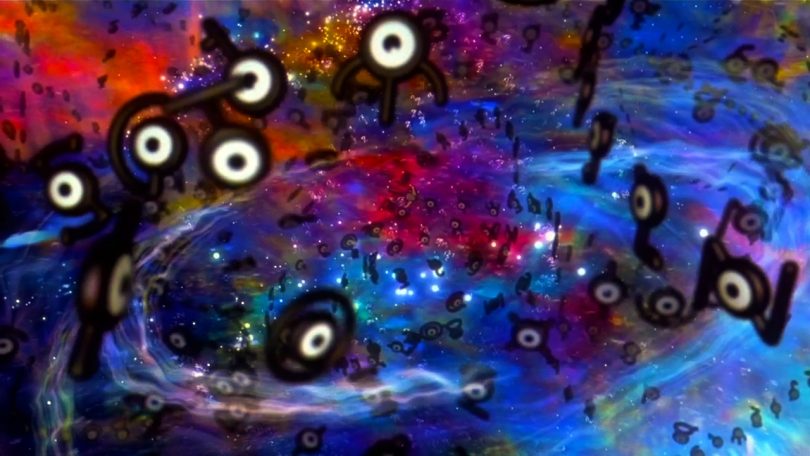Pokémon come in many shapes and sizes, and the inspirations for their designs are vast and wide. The second generation of Pokémon only consisted of one hundred newcomers, and a lot of the Gold & Silver class were simple in design. But, there are a few critters with some certainly quirky origins. I mean, just what is the story behind the likes of Wobbuffet and Dunsparce? Read on, curious Pokémon watchers! A lot of the information in this article comes from the exquisitely detailed Bulbapedia.
Natu and Xatu
Let us begin with the peculiar bird Pokémon, Natu and Xatu. Natu is one of the tiniest Pokémon in the list, and because its wings are so small, it resorts to hopping around. Natu is either based on a parrot, kakapo, or quail. Xatu takes inspiration from both Native American and Mesoamerican religions. Xatu looks like a totem pole, “Xat” being a type of Native American totem pole. Its colourful feathers and breast are red and green, based on that of the resplendent quetzal. The bird is revered in Mesoamerican culture, and “quetzal” can mean “erected”, and Xatu does like standing around a lot. Xatu is known to meditate at sunrise, and stop at sunset. This is a nod to Sun Gazing, an Aztec and Mayan form of spiritual meditation, believing it will give the user supernatural power. Thus, Xatu is a psychic-type.
Unown
The Unown are kind of boring. There are over twenty-six variations of these cycloptic, alphabetic Pokémon, who hang out in the Ruins of Alph. They are based on the Latin alphabet, but are similar to hieroglyphics, in relation to their ruin-dwelling. That’s about it. But, in the anime, they are certainly a lot more impressive, powerful, and Lovecraftian. In the third film, the Unown are presented as reality-warping creatures straight from the realm of Cthulhu. They even dwell in their own freaky alternate dimension, abduct innocent archaeologists, and turn the world into a H.R. Giger saccharine nightmare based on a lonely little girl’s PTSD. The movie’s take on Unown might take inspiration from Yog-Sothoth, a cosmic Lovecraftian entity said to exist outside of the universe.
Wobbuffet
Wobbuffet is one of the Pokémon whose cultural references don’t quite translate to a western audience. His English name mostly relates to his resemblance to a punching bag, and speciality in redirecting attacks. Wobbuffet’s unusual appearance is based on an okigari-koboshi, a traditional handmade Japanese doll. This doll is made from paper-mache, doubling as a roly poly toy, and often features closed eyes and a crooked smile. Wobbuffet’s peculiar salute is a nod to the late Japanese comedian, Hayashiya Sanpei, who used the trademark line “Sō nansu, okusan!”, which translates to “That’s the way it is, ma’am.” Wobbuffet’s Japanese name is a pun on this catchphrase. Wobbuffet’s jokey name stretches to its pre-evolution, Wynaut. Wynaut’s original name, “Sohnano”, can mean “Really?”, so when Wobbuffet and Wynaut talk in Japanese, they are having a recycled conversation.
Dunsparce
Dunsparce is another Pokémon who is rather weirdly forgettable. Despite its strange appearance, Dunsparce is only a normal-type, lacks evolutions, and has poor stats. Even the anime acknowledged them to be dull. It is based on the Tsuchinoko, a Japanese serpentine cryptid. Akin to Bigfoot or the Chupacabra, there have been many sightings of the Tsuchinoko across Japan. Though snake-like, the beast has a flat body, a prominent bulge in the middle, and a narrow pointed tail. The serpent has poisonous fangs, though Dunsparce lacks these, but can hover using tiny wings. This nods to the Tsuchinoko and its ability to perform a double jump. The wings may come from the Feathered Serpent, a deity in Mesoamerican cultures.
Sneasel and Weavile
Sneasel and Weavile are dark/ice-type Pokémon that resembles weasels, but sport red feathers, and clawed hands. Both are based on the Kamaitachi, a Japanese yokai that resembles a weasel and sports sickled claws. It is said that the Kamaitachi attack people, leaving cuts with their claws, often associated with cold weather. Both Pokémon appear to take minor inspiration from Egyptian culture, due to their facial marks, and especially Weavile’s feathery crown and the golden oval on its forehead.
Slugma and Magcargo
Sometimes Pokémon are just so fantastically imagined, that it doesn’t matter where they come from. Slugma and Magcargo are slugs/snails made of lava, though the latter has a shell made of hardened magma. How cool is that? In truth, these fatal, fiery garden pests are based on the Cherufe, a man-eating monster from Mapuche mythology. These Chilean beasts are humanoid creatures made from living rock and magma, hanging out in lava pools in volcanic areas. They are known to trigger earthquakes and volcanic eruptions, and the only way to appease them is to chuck someone into lava. Now that’s tasteful. Imagine having to do that in the games in order to capture Slugma – just throw one of your beloved Pokémon into lava and watch it burn, melt, and die!
Houndour and Houndoom
After my completely justified delusional ranting, let’s move on to Houndour and Houndoom. Pokémon generally avoids using Christianity-related motifs, but it looks like they took some hellish inspiration for Houndour and Houndoom. Both Doberman-like canines take inspiration from Cerberus, the three-headed dog of Greek myths, and mythical hellhounds believed to dwell in Hell. Houndoom sports large curving horns and a forked tale, no doubt taken from the Devil. Both can breathe fire, and are known to be aggressive dogs. Houndour, being black, may be a nod to the Black Dog, a nocturnal shapeshifter that appears in many tales from across the British isles. These include the Black Shuck, Capelthwaite, and Padfoot (the inspiration behind Sirius Black’s animagus form in Harry Potter).
Raikou, Entei, and Suicune
Finally, we have the three Legendary Beasts – Raikou, Entei, and Suicune. The three elusive Pokémon are servants to Ho-Oh, resurrected as guardian beasts after dying in a fire. The three kicked off the “wild goose chase” method of catching legendaries, causing many wasted hours of gameplay. Anyhoo, the trio represent the elements of thunder, fire, and water, each resembling large wild cats. Raikou resembles a tiger/smilodon, but is based on Raiju, a Japanese thunder demon, which can appear as a tiger or a blue wolf wrapped in lightning, explaining its tail. Entei resembles a Chinese guardian lion, which would explain his protective role in the amazing third Pokémon movie. His lion-visage and masked face is said to come from the Barong, a Balinese lion spirit, that killed an evil witch to bring about balance in the universe. Suicune is so awesome that she got her own game in Pokémon Crystal. She is a fusion of two mythical creatures: The Qilin, a Chinese beast said to be able to walk on water and purify it, and Fujin, the Shinto personification of the North Wind.
Which Pokémon are amongst your favourites from the second generation? What myths or parts of culture would you like to see be personified as Pokémon? Leave a comment below, or on our Twitter or Facebook feeds.









